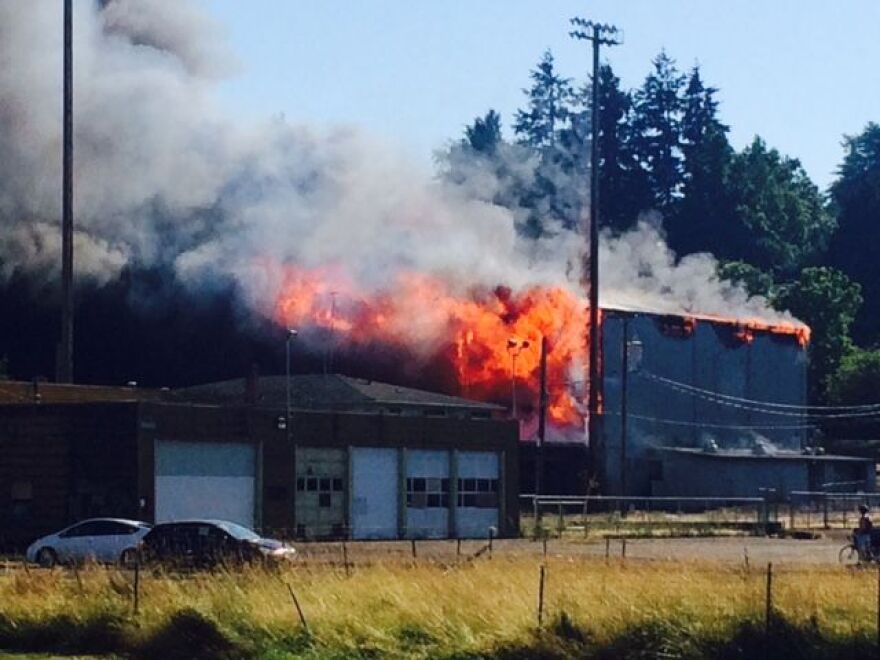Of all the natural elements—fire seems to elicit our most primal responses. Human fascination with fire starts early and some research reveals the less we learn about fire as kids—the stronger our curiosity grows into adulthood. KLCC's Tiffany Eckert takes a look at societal views and how we educate children about the function and the dangers of fire.
Hollywood figured out long ago that nothing captures a scene like an exploding fireball.
(sound of explosion and fireballs)
In the new age of video gaming—the same thing goes...
(sound of video game and rocket launchers)
With bursts of flames but—rarely do they deal with smoke or the consequences of fire.
Johnston: “So it’s just the fun burning and the superhero that’s flying through the flames. And it’s not accurate. That’s not real.”
That’s Sandra Johnston.
Johnston: "I'm a deputy Fire Marshall with the Eugene Springfield Fire Department."
The Fire Marshall's office is responsible for investigating fires to find origin and cause. But the bulk of their work is fire prevention and much of that comes through public education.
Every 1st grader in Eugene Springfield schools is reached through "Friends for Fire Safety." They get the chance to meet Cody or Casey.

Johnston: "A canine Dalmatian goes into the classrooms. He demonstrates how to crawl low under smoke and how to test a smoke alarm. He also goes through being able to dial 911 in an emergency."
Having a real live spotted dog in the classroom—like the ones in the classic cartoon-- is just the ticket to keeping a group of 6-year olds face forward. And Johnston says the youngsters seem to get it—at least in theory.
By 2nd grade, kids get another fire message when shiny, red fire engines visit schools. They talk about prevention—“Keep what’s hot away from what’s not.” And, the old adage, “don’t play with matches.”
Johnston: “Matches and lighters are tools not toys.”
Most of us have heard this one—everyone in the home should know the escape route. Johnston says families should go over and over it because once a fire breaks out, it’s too late to practice.
Johnston: “You can’t rely on the fact that you think you’ll know in the moment, cause you won’t. You need to know that mom goes and gets little Johnny and dad goes and gets Susie. Then they meet at this one place. That’s got to be the routine so you’ve got that muscle memory to get out and of course, stay out.”
The Fire Marshall sees a lot of fires in and around households.
Johnston: “Most everything in our homes is flammable or combustible. It’s ready fuel that can burn if given the opportunity.”
When the fascination with fire meets opportunity—that can spell trouble. Johnston says the Fire Marshall’s office receives calls from teachers, babysitters, bus drivers and most often parents—looking for help with a child. A typical referral might sound like this:
Johnston: “I noticed some burn marks on my daughter’s floor in her room…’ And then we actually go into a screening tool we use to get an idea what the incident was.”
Johnston says her office has a responsibility to teach kids about fire—but when it comes to safety—nothing takes the place of family.
Johnston: “Kids are watching parents. Your expressed respect for fire is a lot of times what your children are going to model after. If the smoke alarm sounds and you don’t get up out of bed, they’re gonna see that they don’t need to get up outta bed.”
So, are we setting good examples for our kids when it comes to fire? I asked myself that and decided to test it out. I got my 10-year old son, together with a few of his buddies to find out what they know and don’t know about fire.

Reporter: “What do you think about when you hear the word fire?”
Kids: “Hot. Dangerous. Burning. It’ll set houses on fire or forest fires.”
Reporter: “If your clothes were on fire, Osi, would you try to run to somebody or would you think about stop drop and roll around.”
Osi: “Stop drop and roll around. Because if I ran to somebody I’d still be burning.”
Reporter: “Sean, what’s your escape route?”
Sean: “Well, I would probably go over to the door and feel with my hand to see if it was on fire on the other side. And if it was I would open the window, kick out the screen and go over to the neighbors and regroup there.”
Reporter: “This is a big question. What would you do if one of your buddies, maybe one of you, had a book of matches or found a lighter and you wanted to just build a little fire somewhere? Evan what do you think?”
Evan: “Um, I would ask them where they were gonna build the fire and if it seemed like a safe place then I would ask somebody, my parents or somebody. And if they said yes then, yeh, we would build a little, small fire. I guess. Safely.”
Reporter: “What’s safely mean?”
Evan: “Uh, small, contained.”
Reporter: “What if the fire got out of control anyway? Because, you fire does that. What would you do?”
Evan: “We would probably have a bucket of water with us or something. So if it got out of control we could calm it down, I guess.”
These are typical kids. They have heard the sirens and seen the aftermath of recent fires in their community. They also love to sit around campfires and make s’mores. Some of their answers here reveal an understanding of fire. Others, not so much… So, the take away for all of us: Don’t leave matches and lighters lying around. Practice an escape plan. Really talk to kids about fire. We will all be safer for it.






